Managing Innovation Report: Just Eat and Innovation Theories
VerifiedAdded on 2022/12/22
|12
|3880
|1
Report
AI Summary
This report provides a comprehensive analysis of disruptive innovation theory, exploring its definitions, principles, and processes. It evaluates the theory's benefits and limitations, followed by an application of the theory to the case of Just Eat, an online food ordering and delivery service. The report delves into Just Eat's company background, historical development, and business model canvas, illustrating how disruptive innovation has shaped its growth. Finally, it suggests potential future development pathways for Just Eat based on the principles of disruptive innovation, offering insights into how the company can continue to innovate and maintain its competitive edge in the market. The report utilizes a structured approach, with a focus on the application of theory to a real-world business context, and also contains a brief introduction to the chosen innovation theory and the company background.
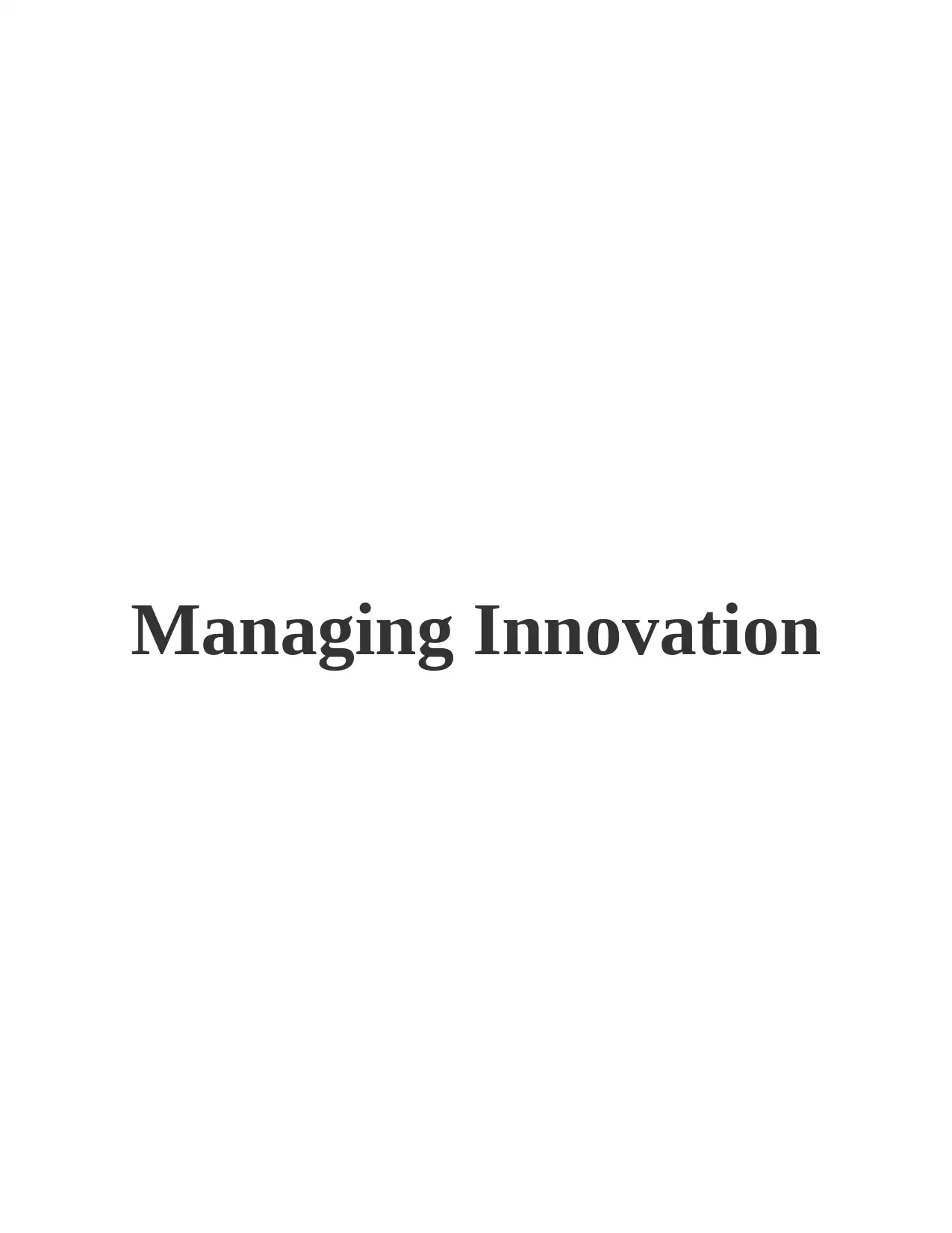
Managing Innovation
Paraphrase This Document
Need a fresh take? Get an instant paraphrase of this document with our AI Paraphraser
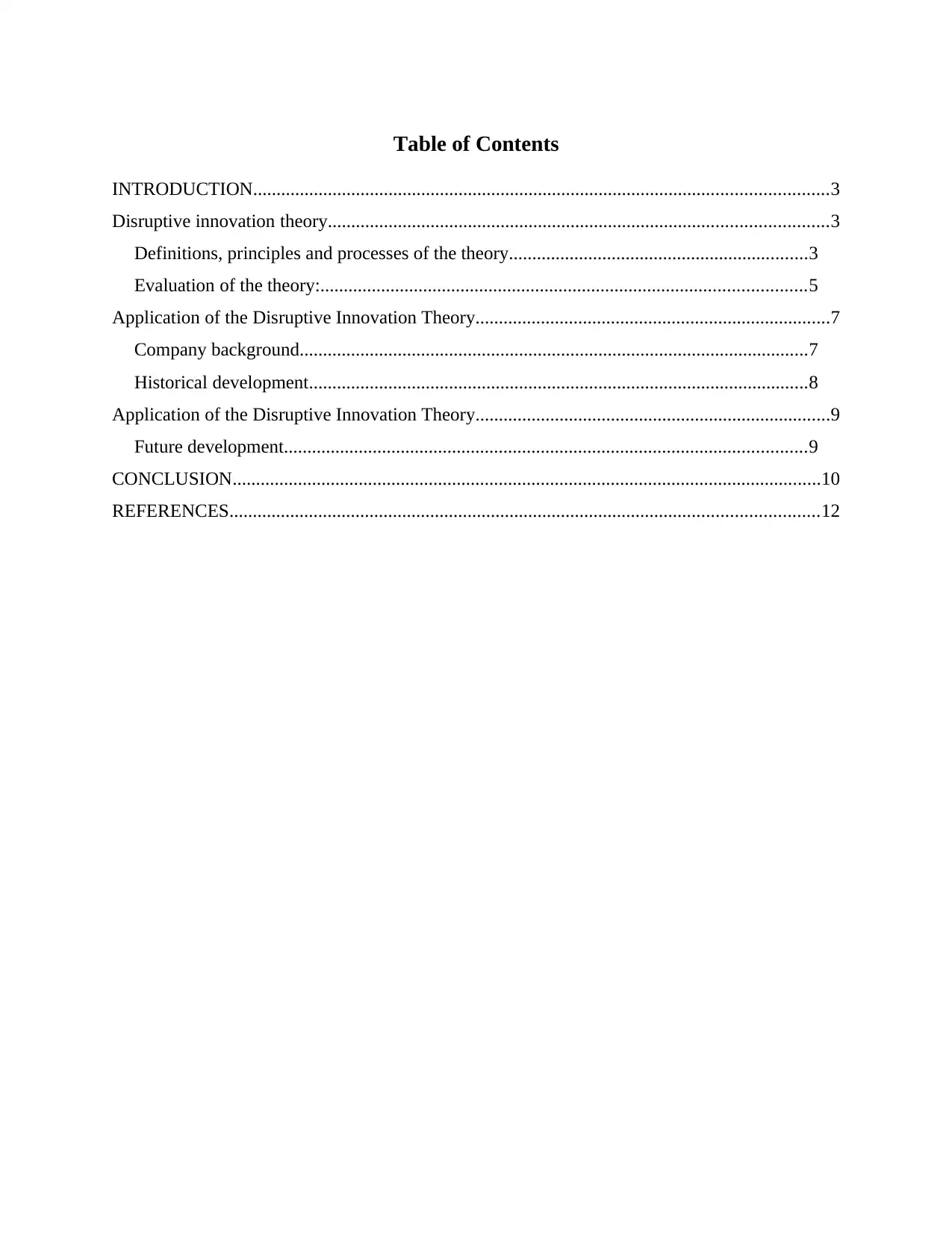
Table of Contents
INTRODUCTION...........................................................................................................................3
Disruptive innovation theory...........................................................................................................3
Definitions, principles and processes of the theory................................................................3
Evaluation of the theory:........................................................................................................5
Application of the Disruptive Innovation Theory............................................................................7
Company background.............................................................................................................7
Historical development...........................................................................................................8
Application of the Disruptive Innovation Theory............................................................................9
Future development................................................................................................................9
CONCLUSION..............................................................................................................................10
REFERENCES..............................................................................................................................12
INTRODUCTION...........................................................................................................................3
Disruptive innovation theory...........................................................................................................3
Definitions, principles and processes of the theory................................................................3
Evaluation of the theory:........................................................................................................5
Application of the Disruptive Innovation Theory............................................................................7
Company background.............................................................................................................7
Historical development...........................................................................................................8
Application of the Disruptive Innovation Theory............................................................................9
Future development................................................................................................................9
CONCLUSION..............................................................................................................................10
REFERENCES..............................................................................................................................12
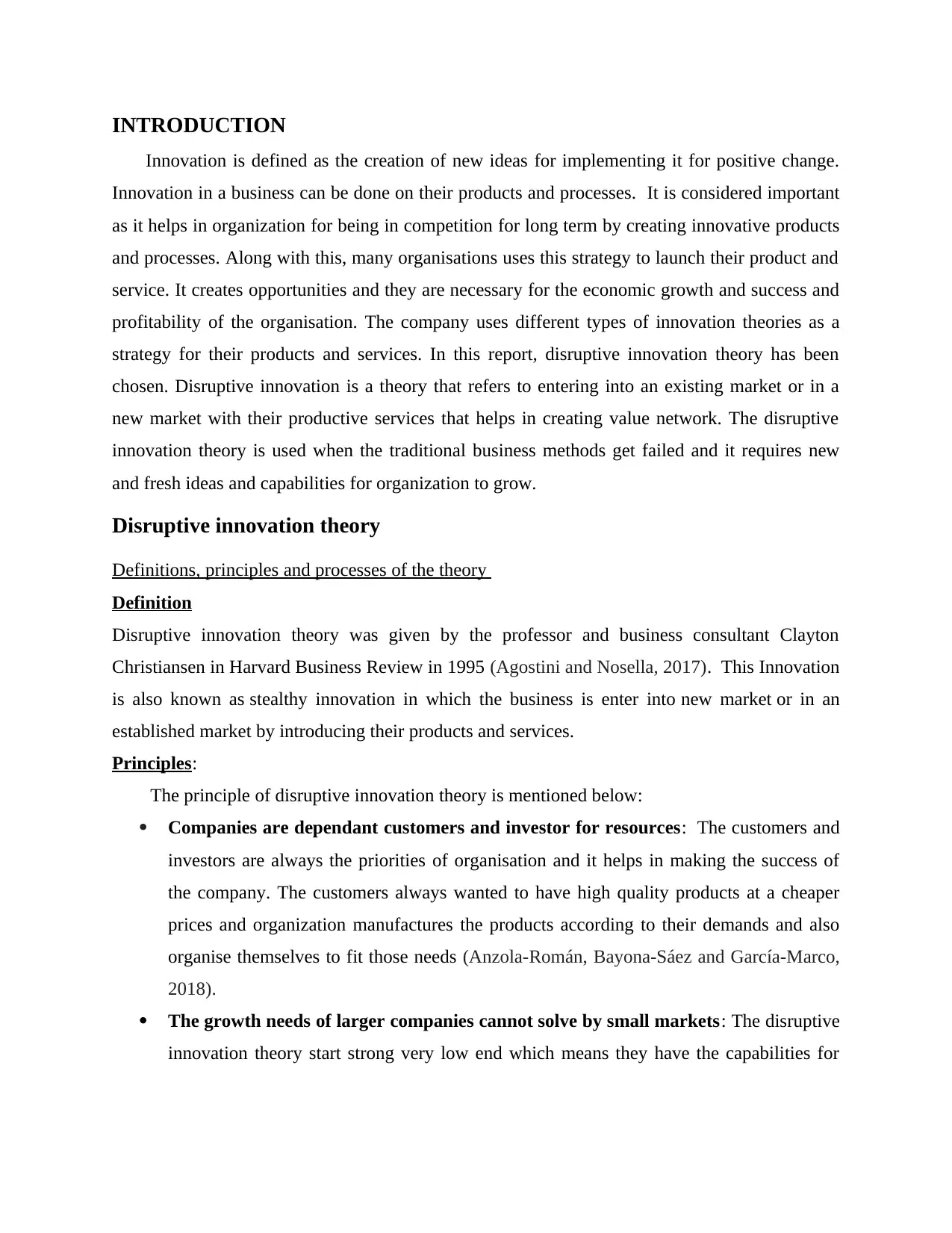
INTRODUCTION
Innovation is defined as the creation of new ideas for implementing it for positive change.
Innovation in a business can be done on their products and processes. It is considered important
as it helps in organization for being in competition for long term by creating innovative products
and processes. Along with this, many organisations uses this strategy to launch their product and
service. It creates opportunities and they are necessary for the economic growth and success and
profitability of the organisation. The company uses different types of innovation theories as a
strategy for their products and services. In this report, disruptive innovation theory has been
chosen. Disruptive innovation is a theory that refers to entering into an existing market or in a
new market with their productive services that helps in creating value network. The disruptive
innovation theory is used when the traditional business methods get failed and it requires new
and fresh ideas and capabilities for organization to grow.
Disruptive innovation theory
Definitions, principles and processes of the theory
Definition
Disruptive innovation theory was given by the professor and business consultant Clayton
Christiansen in Harvard Business Review in 1995 (Agostini and Nosella, 2017). This Innovation
is also known as stealthy innovation in which the business is enter into new market or in an
established market by introducing their products and services.
Principles:
The principle of disruptive innovation theory is mentioned below:
Companies are dependant customers and investor for resources: The customers and
investors are always the priorities of organisation and it helps in making the success of
the company. The customers always wanted to have high quality products at a cheaper
prices and organization manufactures the products according to their demands and also
organise themselves to fit those needs (Anzola-Román, Bayona-Sáez and García-Marco,
2018).
The growth needs of larger companies cannot solve by small markets: The disruptive
innovation theory start strong very low end which means they have the capabilities for
Innovation is defined as the creation of new ideas for implementing it for positive change.
Innovation in a business can be done on their products and processes. It is considered important
as it helps in organization for being in competition for long term by creating innovative products
and processes. Along with this, many organisations uses this strategy to launch their product and
service. It creates opportunities and they are necessary for the economic growth and success and
profitability of the organisation. The company uses different types of innovation theories as a
strategy for their products and services. In this report, disruptive innovation theory has been
chosen. Disruptive innovation is a theory that refers to entering into an existing market or in a
new market with their productive services that helps in creating value network. The disruptive
innovation theory is used when the traditional business methods get failed and it requires new
and fresh ideas and capabilities for organization to grow.
Disruptive innovation theory
Definitions, principles and processes of the theory
Definition
Disruptive innovation theory was given by the professor and business consultant Clayton
Christiansen in Harvard Business Review in 1995 (Agostini and Nosella, 2017). This Innovation
is also known as stealthy innovation in which the business is enter into new market or in an
established market by introducing their products and services.
Principles:
The principle of disruptive innovation theory is mentioned below:
Companies are dependant customers and investor for resources: The customers and
investors are always the priorities of organisation and it helps in making the success of
the company. The customers always wanted to have high quality products at a cheaper
prices and organization manufactures the products according to their demands and also
organise themselves to fit those needs (Anzola-Román, Bayona-Sáez and García-Marco,
2018).
The growth needs of larger companies cannot solve by small markets: The disruptive
innovation theory start strong very low end which means they have the capabilities for
⊘ This is a preview!⊘
Do you want full access?
Subscribe today to unlock all pages.

Trusted by 1+ million students worldwide
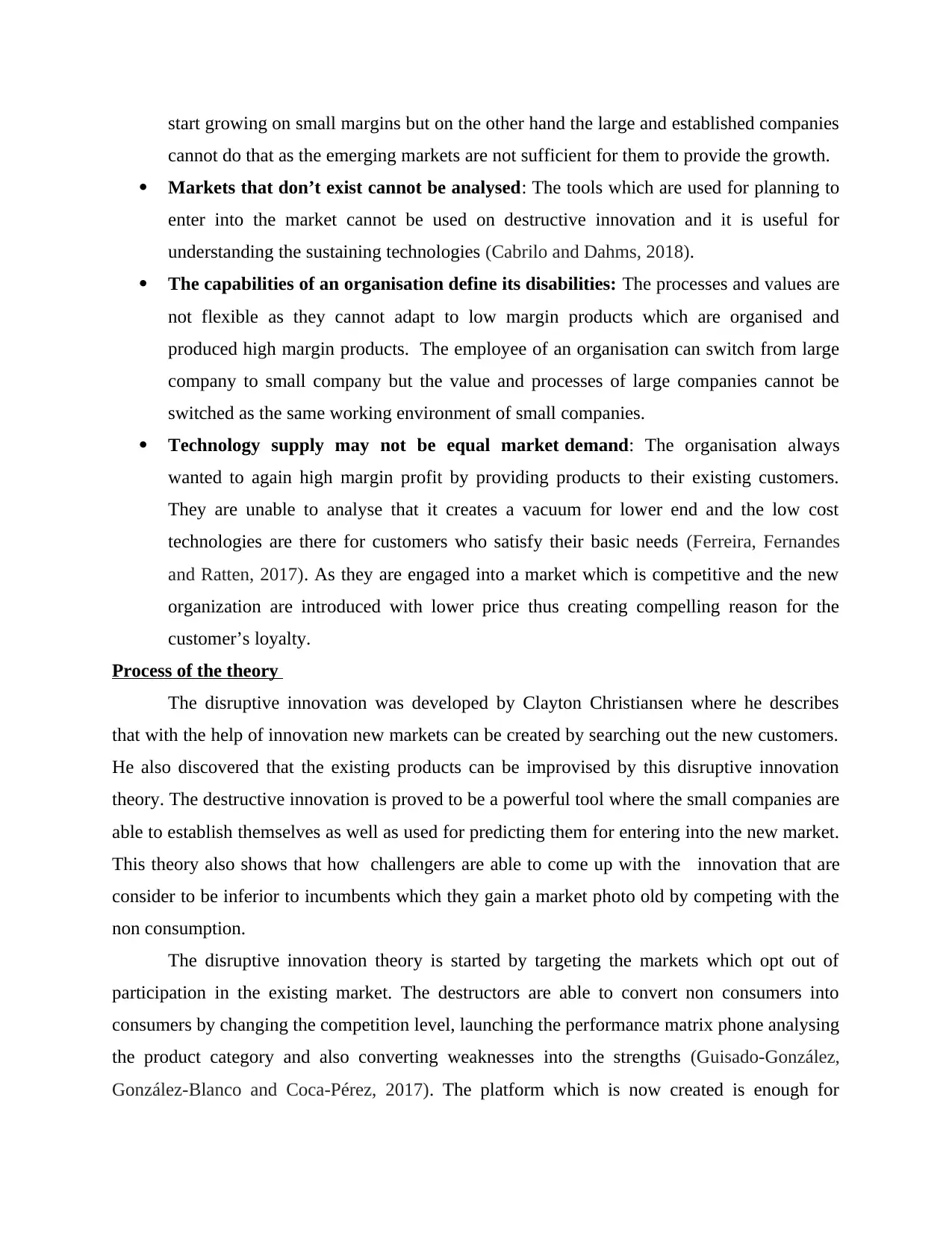
start growing on small margins but on the other hand the large and established companies
cannot do that as the emerging markets are not sufficient for them to provide the growth.
Markets that don’t exist cannot be analysed: The tools which are used for planning to
enter into the market cannot be used on destructive innovation and it is useful for
understanding the sustaining technologies (Cabrilo and Dahms, 2018).
The capabilities of an organisation define its disabilities: The processes and values are
not flexible as they cannot adapt to low margin products which are organised and
produced high margin products. The employee of an organisation can switch from large
company to small company but the value and processes of large companies cannot be
switched as the same working environment of small companies.
Technology supply may not be equal market demand: The organisation always
wanted to again high margin profit by providing products to their existing customers.
They are unable to analyse that it creates a vacuum for lower end and the low cost
technologies are there for customers who satisfy their basic needs (Ferreira, Fernandes
and Ratten, 2017). As they are engaged into a market which is competitive and the new
organization are introduced with lower price thus creating compelling reason for the
customer’s loyalty.
Process of the theory
The disruptive innovation was developed by Clayton Christiansen where he describes
that with the help of innovation new markets can be created by searching out the new customers.
He also discovered that the existing products can be improvised by this disruptive innovation
theory. The destructive innovation is proved to be a powerful tool where the small companies are
able to establish themselves as well as used for predicting them for entering into the new market.
This theory also shows that how challengers are able to come up with the innovation that are
consider to be inferior to incumbents which they gain a market photo old by competing with the
non consumption.
The disruptive innovation theory is started by targeting the markets which opt out of
participation in the existing market. The destructors are able to convert non consumers into
consumers by changing the competition level, launching the performance matrix phone analysing
the product category and also converting weaknesses into the strengths (Guisado-González,
González-Blanco and Coca-Pérez, 2017). The platform which is now created is enough for
cannot do that as the emerging markets are not sufficient for them to provide the growth.
Markets that don’t exist cannot be analysed: The tools which are used for planning to
enter into the market cannot be used on destructive innovation and it is useful for
understanding the sustaining technologies (Cabrilo and Dahms, 2018).
The capabilities of an organisation define its disabilities: The processes and values are
not flexible as they cannot adapt to low margin products which are organised and
produced high margin products. The employee of an organisation can switch from large
company to small company but the value and processes of large companies cannot be
switched as the same working environment of small companies.
Technology supply may not be equal market demand: The organisation always
wanted to again high margin profit by providing products to their existing customers.
They are unable to analyse that it creates a vacuum for lower end and the low cost
technologies are there for customers who satisfy their basic needs (Ferreira, Fernandes
and Ratten, 2017). As they are engaged into a market which is competitive and the new
organization are introduced with lower price thus creating compelling reason for the
customer’s loyalty.
Process of the theory
The disruptive innovation was developed by Clayton Christiansen where he describes
that with the help of innovation new markets can be created by searching out the new customers.
He also discovered that the existing products can be improvised by this disruptive innovation
theory. The destructive innovation is proved to be a powerful tool where the small companies are
able to establish themselves as well as used for predicting them for entering into the new market.
This theory also shows that how challengers are able to come up with the innovation that are
consider to be inferior to incumbents which they gain a market photo old by competing with the
non consumption.
The disruptive innovation theory is started by targeting the markets which opt out of
participation in the existing market. The destructors are able to convert non consumers into
consumers by changing the competition level, launching the performance matrix phone analysing
the product category and also converting weaknesses into the strengths (Guisado-González,
González-Blanco and Coca-Pérez, 2017). The platform which is now created is enough for
Paraphrase This Document
Need a fresh take? Get an instant paraphrase of this document with our AI Paraphraser
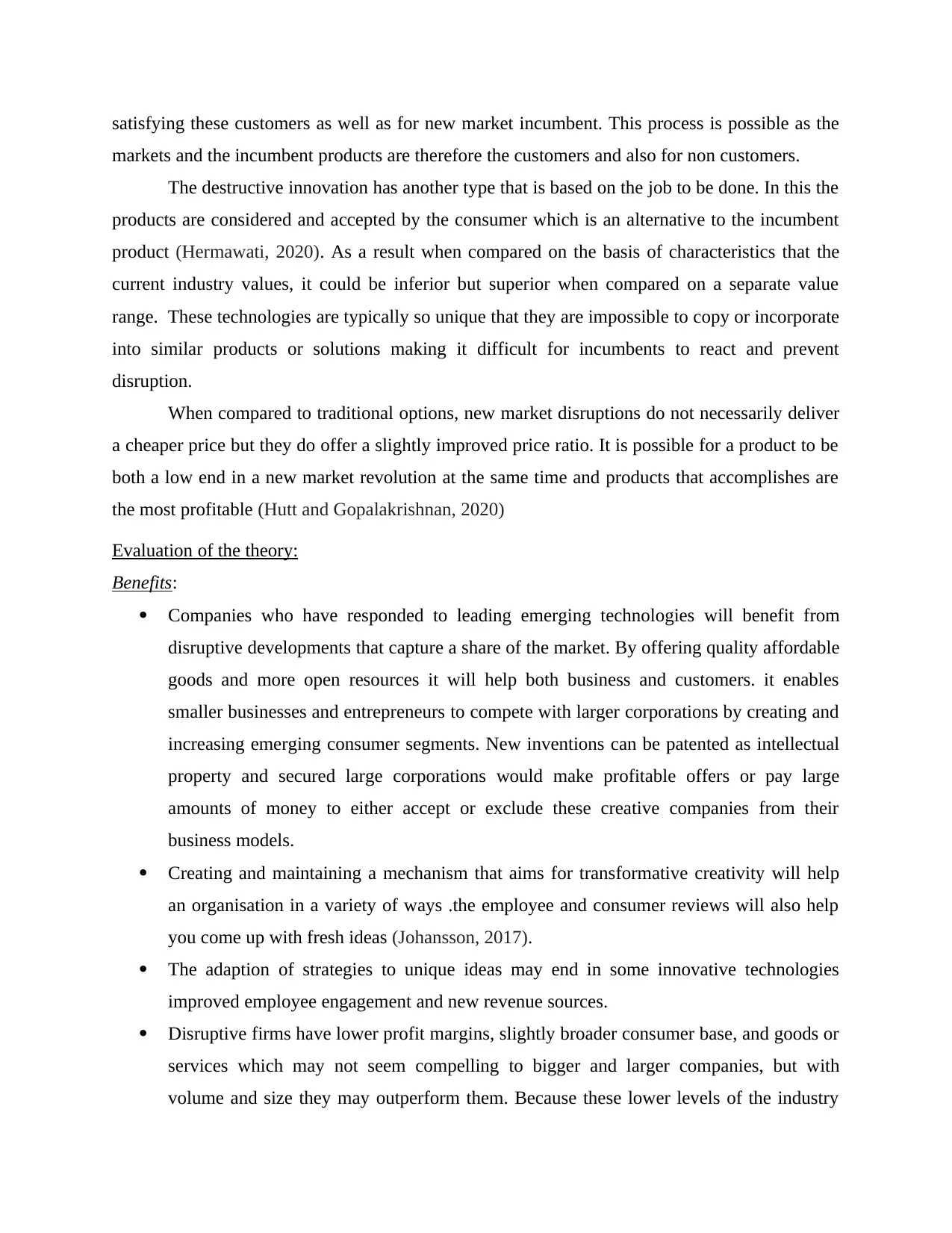
satisfying these customers as well as for new market incumbent. This process is possible as the
markets and the incumbent products are therefore the customers and also for non customers.
The destructive innovation has another type that is based on the job to be done. In this the
products are considered and accepted by the consumer which is an alternative to the incumbent
product (Hermawati, 2020). As a result when compared on the basis of characteristics that the
current industry values, it could be inferior but superior when compared on a separate value
range. These technologies are typically so unique that they are impossible to copy or incorporate
into similar products or solutions making it difficult for incumbents to react and prevent
disruption.
When compared to traditional options, new market disruptions do not necessarily deliver
a cheaper price but they do offer a slightly improved price ratio. It is possible for a product to be
both a low end in a new market revolution at the same time and products that accomplishes are
the most profitable (Hutt and Gopalakrishnan, 2020)
Evaluation of the theory:
Benefits:
Companies who have responded to leading emerging technologies will benefit from
disruptive developments that capture a share of the market. By offering quality affordable
goods and more open resources it will help both business and customers. it enables
smaller businesses and entrepreneurs to compete with larger corporations by creating and
increasing emerging consumer segments. New inventions can be patented as intellectual
property and secured large corporations would make profitable offers or pay large
amounts of money to either accept or exclude these creative companies from their
business models.
Creating and maintaining a mechanism that aims for transformative creativity will help
an organisation in a variety of ways .the employee and consumer reviews will also help
you come up with fresh ideas (Johansson, 2017).
The adaption of strategies to unique ideas may end in some innovative technologies
improved employee engagement and new revenue sources.
Disruptive firms have lower profit margins, slightly broader consumer base, and goods or
services which may not seem compelling to bigger and larger companies, but with
volume and size they may outperform them. Because these lower levels of the industry
markets and the incumbent products are therefore the customers and also for non customers.
The destructive innovation has another type that is based on the job to be done. In this the
products are considered and accepted by the consumer which is an alternative to the incumbent
product (Hermawati, 2020). As a result when compared on the basis of characteristics that the
current industry values, it could be inferior but superior when compared on a separate value
range. These technologies are typically so unique that they are impossible to copy or incorporate
into similar products or solutions making it difficult for incumbents to react and prevent
disruption.
When compared to traditional options, new market disruptions do not necessarily deliver
a cheaper price but they do offer a slightly improved price ratio. It is possible for a product to be
both a low end in a new market revolution at the same time and products that accomplishes are
the most profitable (Hutt and Gopalakrishnan, 2020)
Evaluation of the theory:
Benefits:
Companies who have responded to leading emerging technologies will benefit from
disruptive developments that capture a share of the market. By offering quality affordable
goods and more open resources it will help both business and customers. it enables
smaller businesses and entrepreneurs to compete with larger corporations by creating and
increasing emerging consumer segments. New inventions can be patented as intellectual
property and secured large corporations would make profitable offers or pay large
amounts of money to either accept or exclude these creative companies from their
business models.
Creating and maintaining a mechanism that aims for transformative creativity will help
an organisation in a variety of ways .the employee and consumer reviews will also help
you come up with fresh ideas (Johansson, 2017).
The adaption of strategies to unique ideas may end in some innovative technologies
improved employee engagement and new revenue sources.
Disruptive firms have lower profit margins, slightly broader consumer base, and goods or
services which may not seem compelling to bigger and larger companies, but with
volume and size they may outperform them. Because these lower levels of the industry
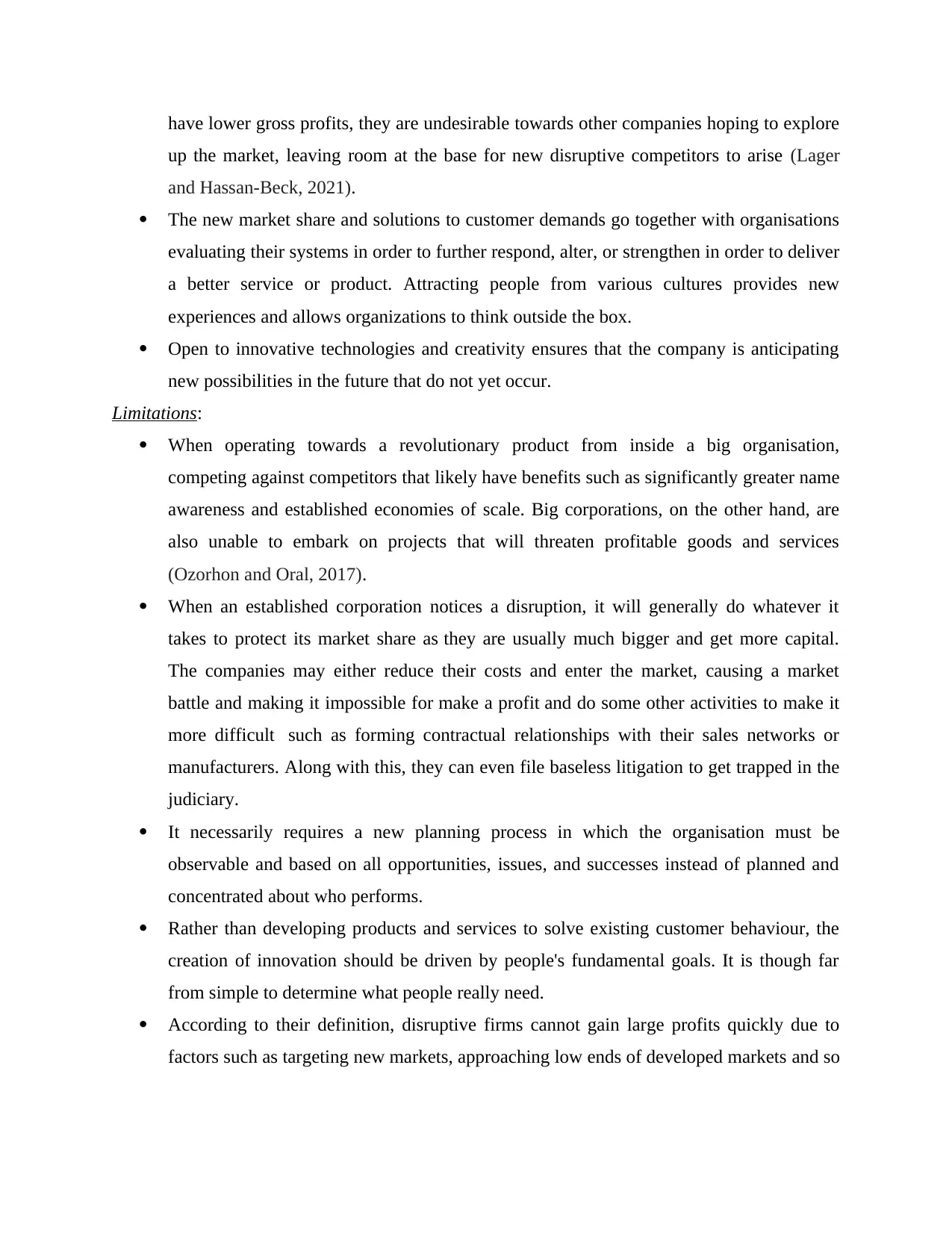
have lower gross profits, they are undesirable towards other companies hoping to explore
up the market, leaving room at the base for new disruptive competitors to arise (Lager
and Hassan-Beck, 2021).
The new market share and solutions to customer demands go together with organisations
evaluating their systems in order to further respond, alter, or strengthen in order to deliver
a better service or product. Attracting people from various cultures provides new
experiences and allows organizations to think outside the box.
Open to innovative technologies and creativity ensures that the company is anticipating
new possibilities in the future that do not yet occur.
Limitations:
When operating towards a revolutionary product from inside a big organisation,
competing against competitors that likely have benefits such as significantly greater name
awareness and established economies of scale. Big corporations, on the other hand, are
also unable to embark on projects that will threaten profitable goods and services
(Ozorhon and Oral, 2017).
When an established corporation notices a disruption, it will generally do whatever it
takes to protect its market share as they are usually much bigger and get more capital.
The companies may either reduce their costs and enter the market, causing a market
battle and making it impossible for make a profit and do some other activities to make it
more difficult such as forming contractual relationships with their sales networks or
manufacturers. Along with this, they can even file baseless litigation to get trapped in the
judiciary.
It necessarily requires a new planning process in which the organisation must be
observable and based on all opportunities, issues, and successes instead of planned and
concentrated about who performs.
Rather than developing products and services to solve existing customer behaviour, the
creation of innovation should be driven by people's fundamental goals. It is though far
from simple to determine what people really need.
According to their definition, disruptive firms cannot gain large profits quickly due to
factors such as targeting new markets, approaching low ends of developed markets and so
up the market, leaving room at the base for new disruptive competitors to arise (Lager
and Hassan-Beck, 2021).
The new market share and solutions to customer demands go together with organisations
evaluating their systems in order to further respond, alter, or strengthen in order to deliver
a better service or product. Attracting people from various cultures provides new
experiences and allows organizations to think outside the box.
Open to innovative technologies and creativity ensures that the company is anticipating
new possibilities in the future that do not yet occur.
Limitations:
When operating towards a revolutionary product from inside a big organisation,
competing against competitors that likely have benefits such as significantly greater name
awareness and established economies of scale. Big corporations, on the other hand, are
also unable to embark on projects that will threaten profitable goods and services
(Ozorhon and Oral, 2017).
When an established corporation notices a disruption, it will generally do whatever it
takes to protect its market share as they are usually much bigger and get more capital.
The companies may either reduce their costs and enter the market, causing a market
battle and making it impossible for make a profit and do some other activities to make it
more difficult such as forming contractual relationships with their sales networks or
manufacturers. Along with this, they can even file baseless litigation to get trapped in the
judiciary.
It necessarily requires a new planning process in which the organisation must be
observable and based on all opportunities, issues, and successes instead of planned and
concentrated about who performs.
Rather than developing products and services to solve existing customer behaviour, the
creation of innovation should be driven by people's fundamental goals. It is though far
from simple to determine what people really need.
According to their definition, disruptive firms cannot gain large profits quickly due to
factors such as targeting new markets, approaching low ends of developed markets and so
⊘ This is a preview!⊘
Do you want full access?
Subscribe today to unlock all pages.

Trusted by 1+ million students worldwide
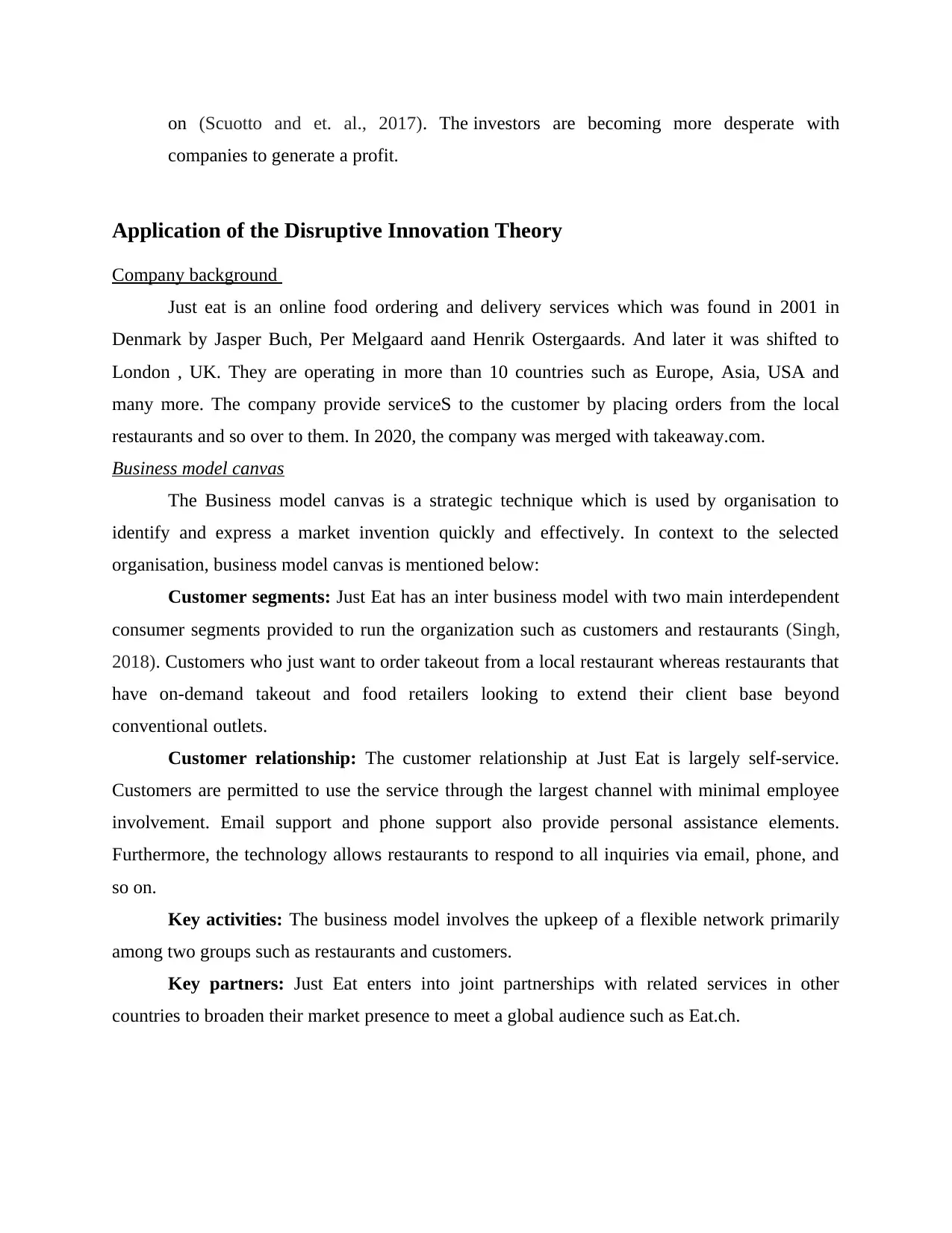
on (Scuotto and et. al., 2017). The investors are becoming more desperate with
companies to generate a profit.
Application of the Disruptive Innovation Theory
Company background
Just eat is an online food ordering and delivery services which was found in 2001 in
Denmark by Jasper Buch, Per Melgaard aand Henrik Ostergaards. And later it was shifted to
London , UK. They are operating in more than 10 countries such as Europe, Asia, USA and
many more. The company provide serviceS to the customer by placing orders from the local
restaurants and so over to them. In 2020, the company was merged with takeaway.com.
Business model canvas
The Business model canvas is a strategic technique which is used by organisation to
identify and express a market invention quickly and effectively. In context to the selected
organisation, business model canvas is mentioned below:
Customer segments: Just Eat has an inter business model with two main interdependent
consumer segments provided to run the organization such as customers and restaurants (Singh,
2018). Customers who just want to order takeout from a local restaurant whereas restaurants that
have on-demand takeout and food retailers looking to extend their client base beyond
conventional outlets.
Customer relationship: The customer relationship at Just Eat is largely self-service.
Customers are permitted to use the service through the largest channel with minimal employee
involvement. Email support and phone support also provide personal assistance elements.
Furthermore, the technology allows restaurants to respond to all inquiries via email, phone, and
so on.
Key activities: The business model involves the upkeep of a flexible network primarily
among two groups such as restaurants and customers.
Key partners: Just Eat enters into joint partnerships with related services in other
countries to broaden their market presence to meet a global audience such as Eat.ch.
companies to generate a profit.
Application of the Disruptive Innovation Theory
Company background
Just eat is an online food ordering and delivery services which was found in 2001 in
Denmark by Jasper Buch, Per Melgaard aand Henrik Ostergaards. And later it was shifted to
London , UK. They are operating in more than 10 countries such as Europe, Asia, USA and
many more. The company provide serviceS to the customer by placing orders from the local
restaurants and so over to them. In 2020, the company was merged with takeaway.com.
Business model canvas
The Business model canvas is a strategic technique which is used by organisation to
identify and express a market invention quickly and effectively. In context to the selected
organisation, business model canvas is mentioned below:
Customer segments: Just Eat has an inter business model with two main interdependent
consumer segments provided to run the organization such as customers and restaurants (Singh,
2018). Customers who just want to order takeout from a local restaurant whereas restaurants that
have on-demand takeout and food retailers looking to extend their client base beyond
conventional outlets.
Customer relationship: The customer relationship at Just Eat is largely self-service.
Customers are permitted to use the service through the largest channel with minimal employee
involvement. Email support and phone support also provide personal assistance elements.
Furthermore, the technology allows restaurants to respond to all inquiries via email, phone, and
so on.
Key activities: The business model involves the upkeep of a flexible network primarily
among two groups such as restaurants and customers.
Key partners: Just Eat enters into joint partnerships with related services in other
countries to broaden their market presence to meet a global audience such as Eat.ch.
Paraphrase This Document
Need a fresh take? Get an instant paraphrase of this document with our AI Paraphraser
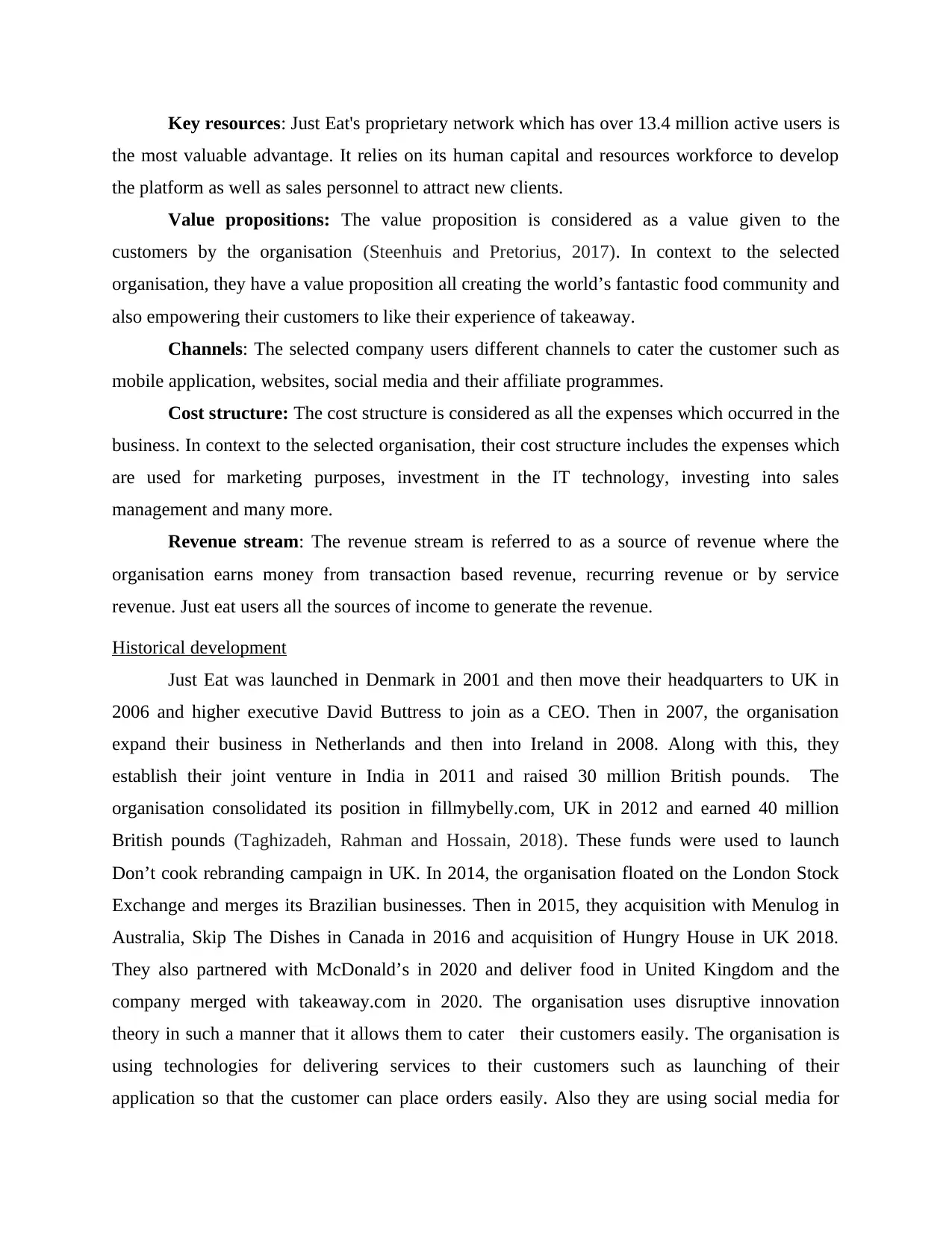
Key resources: Just Eat's proprietary network which has over 13.4 million active users is
the most valuable advantage. It relies on its human capital and resources workforce to develop
the platform as well as sales personnel to attract new clients.
Value propositions: The value proposition is considered as a value given to the
customers by the organisation (Steenhuis and Pretorius, 2017). In context to the selected
organisation, they have a value proposition all creating the world’s fantastic food community and
also empowering their customers to like their experience of takeaway.
Channels: The selected company users different channels to cater the customer such as
mobile application, websites, social media and their affiliate programmes.
Cost structure: The cost structure is considered as all the expenses which occurred in the
business. In context to the selected organisation, their cost structure includes the expenses which
are used for marketing purposes, investment in the IT technology, investing into sales
management and many more.
Revenue stream: The revenue stream is referred to as a source of revenue where the
organisation earns money from transaction based revenue, recurring revenue or by service
revenue. Just eat users all the sources of income to generate the revenue.
Historical development
Just Eat was launched in Denmark in 2001 and then move their headquarters to UK in
2006 and higher executive David Buttress to join as a CEO. Then in 2007, the organisation
expand their business in Netherlands and then into Ireland in 2008. Along with this, they
establish their joint venture in India in 2011 and raised 30 million British pounds. The
organisation consolidated its position in fillmybelly.com, UK in 2012 and earned 40 million
British pounds (Taghizadeh, Rahman and Hossain, 2018). These funds were used to launch
Don’t cook rebranding campaign in UK. In 2014, the organisation floated on the London Stock
Exchange and merges its Brazilian businesses. Then in 2015, they acquisition with Menulog in
Australia, Skip The Dishes in Canada in 2016 and acquisition of Hungry House in UK 2018.
They also partnered with McDonald’s in 2020 and deliver food in United Kingdom and the
company merged with takeaway.com in 2020. The organisation uses disruptive innovation
theory in such a manner that it allows them to cater their customers easily. The organisation is
using technologies for delivering services to their customers such as launching of their
application so that the customer can place orders easily. Also they are using social media for
the most valuable advantage. It relies on its human capital and resources workforce to develop
the platform as well as sales personnel to attract new clients.
Value propositions: The value proposition is considered as a value given to the
customers by the organisation (Steenhuis and Pretorius, 2017). In context to the selected
organisation, they have a value proposition all creating the world’s fantastic food community and
also empowering their customers to like their experience of takeaway.
Channels: The selected company users different channels to cater the customer such as
mobile application, websites, social media and their affiliate programmes.
Cost structure: The cost structure is considered as all the expenses which occurred in the
business. In context to the selected organisation, their cost structure includes the expenses which
are used for marketing purposes, investment in the IT technology, investing into sales
management and many more.
Revenue stream: The revenue stream is referred to as a source of revenue where the
organisation earns money from transaction based revenue, recurring revenue or by service
revenue. Just eat users all the sources of income to generate the revenue.
Historical development
Just Eat was launched in Denmark in 2001 and then move their headquarters to UK in
2006 and higher executive David Buttress to join as a CEO. Then in 2007, the organisation
expand their business in Netherlands and then into Ireland in 2008. Along with this, they
establish their joint venture in India in 2011 and raised 30 million British pounds. The
organisation consolidated its position in fillmybelly.com, UK in 2012 and earned 40 million
British pounds (Taghizadeh, Rahman and Hossain, 2018). These funds were used to launch
Don’t cook rebranding campaign in UK. In 2014, the organisation floated on the London Stock
Exchange and merges its Brazilian businesses. Then in 2015, they acquisition with Menulog in
Australia, Skip The Dishes in Canada in 2016 and acquisition of Hungry House in UK 2018.
They also partnered with McDonald’s in 2020 and deliver food in United Kingdom and the
company merged with takeaway.com in 2020. The organisation uses disruptive innovation
theory in such a manner that it allows them to cater their customers easily. The organisation is
using technologies for delivering services to their customers such as launching of their
application so that the customer can place orders easily. Also they are using social media for
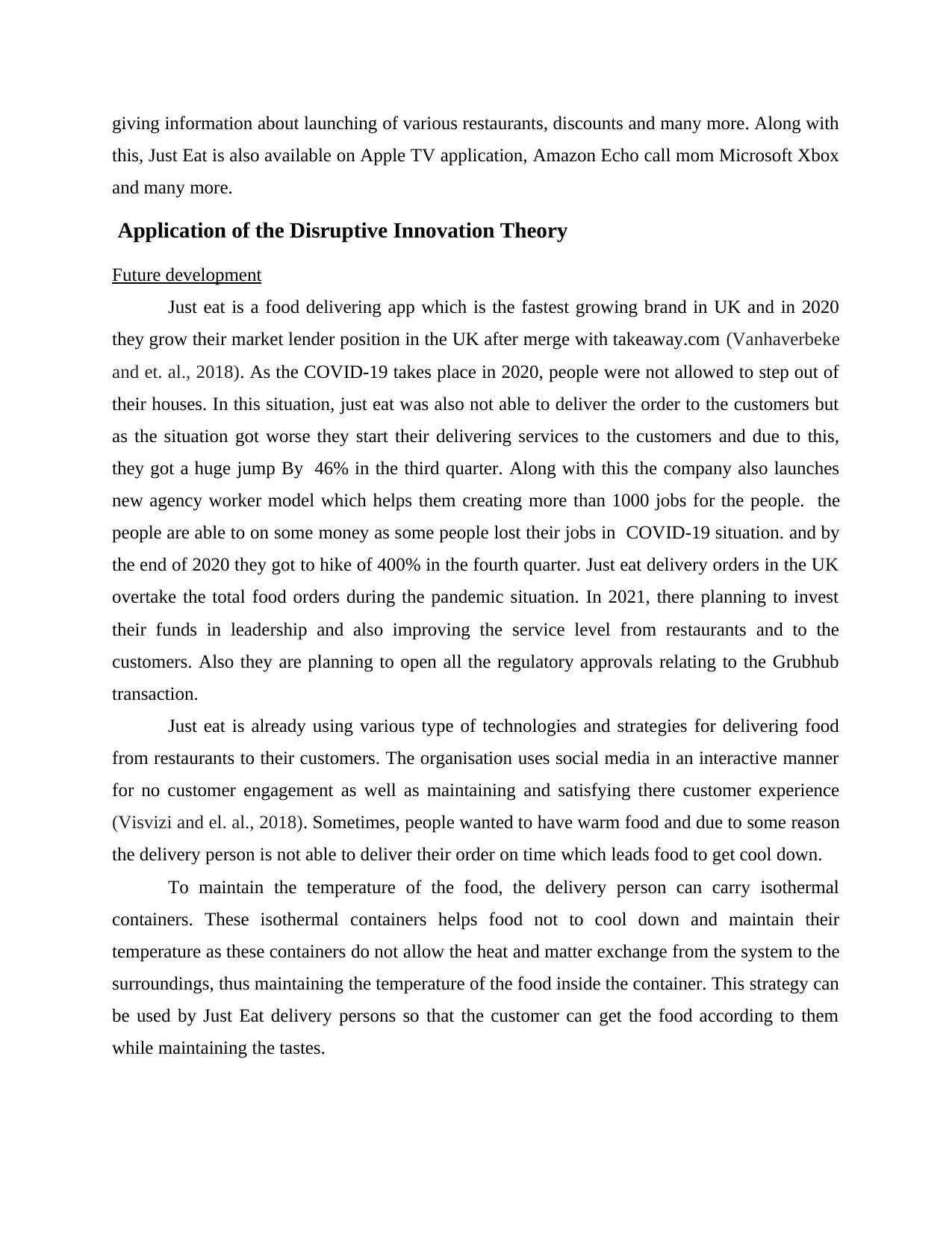
giving information about launching of various restaurants, discounts and many more. Along with
this, Just Eat is also available on Apple TV application, Amazon Echo call mom Microsoft Xbox
and many more.
Application of the Disruptive Innovation Theory
Future development
Just eat is a food delivering app which is the fastest growing brand in UK and in 2020
they grow their market lender position in the UK after merge with takeaway.com (Vanhaverbeke
and et. al., 2018). As the COVID-19 takes place in 2020, people were not allowed to step out of
their houses. In this situation, just eat was also not able to deliver the order to the customers but
as the situation got worse they start their delivering services to the customers and due to this,
they got a huge jump By 46% in the third quarter. Along with this the company also launches
new agency worker model which helps them creating more than 1000 jobs for the people. the
people are able to on some money as some people lost their jobs in COVID-19 situation. and by
the end of 2020 they got to hike of 400% in the fourth quarter. Just eat delivery orders in the UK
overtake the total food orders during the pandemic situation. In 2021, there planning to invest
their funds in leadership and also improving the service level from restaurants and to the
customers. Also they are planning to open all the regulatory approvals relating to the Grubhub
transaction.
Just eat is already using various type of technologies and strategies for delivering food
from restaurants to their customers. The organisation uses social media in an interactive manner
for no customer engagement as well as maintaining and satisfying there customer experience
(Visvizi and el. al., 2018). Sometimes, people wanted to have warm food and due to some reason
the delivery person is not able to deliver their order on time which leads food to get cool down.
To maintain the temperature of the food, the delivery person can carry isothermal
containers. These isothermal containers helps food not to cool down and maintain their
temperature as these containers do not allow the heat and matter exchange from the system to the
surroundings, thus maintaining the temperature of the food inside the container. This strategy can
be used by Just Eat delivery persons so that the customer can get the food according to them
while maintaining the tastes.
this, Just Eat is also available on Apple TV application, Amazon Echo call mom Microsoft Xbox
and many more.
Application of the Disruptive Innovation Theory
Future development
Just eat is a food delivering app which is the fastest growing brand in UK and in 2020
they grow their market lender position in the UK after merge with takeaway.com (Vanhaverbeke
and et. al., 2018). As the COVID-19 takes place in 2020, people were not allowed to step out of
their houses. In this situation, just eat was also not able to deliver the order to the customers but
as the situation got worse they start their delivering services to the customers and due to this,
they got a huge jump By 46% in the third quarter. Along with this the company also launches
new agency worker model which helps them creating more than 1000 jobs for the people. the
people are able to on some money as some people lost their jobs in COVID-19 situation. and by
the end of 2020 they got to hike of 400% in the fourth quarter. Just eat delivery orders in the UK
overtake the total food orders during the pandemic situation. In 2021, there planning to invest
their funds in leadership and also improving the service level from restaurants and to the
customers. Also they are planning to open all the regulatory approvals relating to the Grubhub
transaction.
Just eat is already using various type of technologies and strategies for delivering food
from restaurants to their customers. The organisation uses social media in an interactive manner
for no customer engagement as well as maintaining and satisfying there customer experience
(Visvizi and el. al., 2018). Sometimes, people wanted to have warm food and due to some reason
the delivery person is not able to deliver their order on time which leads food to get cool down.
To maintain the temperature of the food, the delivery person can carry isothermal
containers. These isothermal containers helps food not to cool down and maintain their
temperature as these containers do not allow the heat and matter exchange from the system to the
surroundings, thus maintaining the temperature of the food inside the container. This strategy can
be used by Just Eat delivery persons so that the customer can get the food according to them
while maintaining the tastes.
⊘ This is a preview!⊘
Do you want full access?
Subscribe today to unlock all pages.

Trusted by 1+ million students worldwide
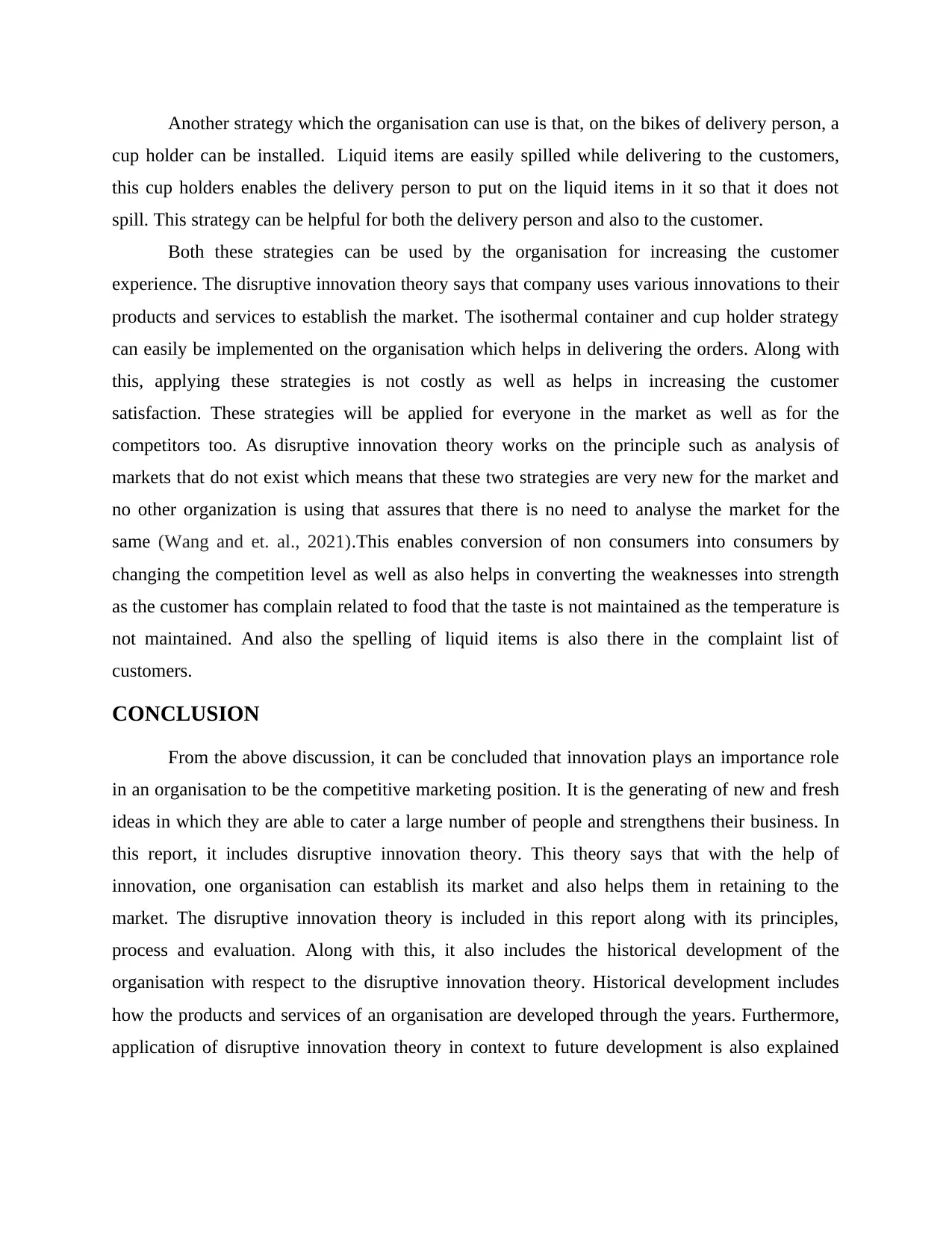
Another strategy which the organisation can use is that, on the bikes of delivery person, a
cup holder can be installed. Liquid items are easily spilled while delivering to the customers,
this cup holders enables the delivery person to put on the liquid items in it so that it does not
spill. This strategy can be helpful for both the delivery person and also to the customer.
Both these strategies can be used by the organisation for increasing the customer
experience. The disruptive innovation theory says that company uses various innovations to their
products and services to establish the market. The isothermal container and cup holder strategy
can easily be implemented on the organisation which helps in delivering the orders. Along with
this, applying these strategies is not costly as well as helps in increasing the customer
satisfaction. These strategies will be applied for everyone in the market as well as for the
competitors too. As disruptive innovation theory works on the principle such as analysis of
markets that do not exist which means that these two strategies are very new for the market and
no other organization is using that assures that there is no need to analyse the market for the
same (Wang and et. al., 2021).This enables conversion of non consumers into consumers by
changing the competition level as well as also helps in converting the weaknesses into strength
as the customer has complain related to food that the taste is not maintained as the temperature is
not maintained. And also the spelling of liquid items is also there in the complaint list of
customers.
CONCLUSION
From the above discussion, it can be concluded that innovation plays an importance role
in an organisation to be the competitive marketing position. It is the generating of new and fresh
ideas in which they are able to cater a large number of people and strengthens their business. In
this report, it includes disruptive innovation theory. This theory says that with the help of
innovation, one organisation can establish its market and also helps them in retaining to the
market. The disruptive innovation theory is included in this report along with its principles,
process and evaluation. Along with this, it also includes the historical development of the
organisation with respect to the disruptive innovation theory. Historical development includes
how the products and services of an organisation are developed through the years. Furthermore,
application of disruptive innovation theory in context to future development is also explained
cup holder can be installed. Liquid items are easily spilled while delivering to the customers,
this cup holders enables the delivery person to put on the liquid items in it so that it does not
spill. This strategy can be helpful for both the delivery person and also to the customer.
Both these strategies can be used by the organisation for increasing the customer
experience. The disruptive innovation theory says that company uses various innovations to their
products and services to establish the market. The isothermal container and cup holder strategy
can easily be implemented on the organisation which helps in delivering the orders. Along with
this, applying these strategies is not costly as well as helps in increasing the customer
satisfaction. These strategies will be applied for everyone in the market as well as for the
competitors too. As disruptive innovation theory works on the principle such as analysis of
markets that do not exist which means that these two strategies are very new for the market and
no other organization is using that assures that there is no need to analyse the market for the
same (Wang and et. al., 2021).This enables conversion of non consumers into consumers by
changing the competition level as well as also helps in converting the weaknesses into strength
as the customer has complain related to food that the taste is not maintained as the temperature is
not maintained. And also the spelling of liquid items is also there in the complaint list of
customers.
CONCLUSION
From the above discussion, it can be concluded that innovation plays an importance role
in an organisation to be the competitive marketing position. It is the generating of new and fresh
ideas in which they are able to cater a large number of people and strengthens their business. In
this report, it includes disruptive innovation theory. This theory says that with the help of
innovation, one organisation can establish its market and also helps them in retaining to the
market. The disruptive innovation theory is included in this report along with its principles,
process and evaluation. Along with this, it also includes the historical development of the
organisation with respect to the disruptive innovation theory. Historical development includes
how the products and services of an organisation are developed through the years. Furthermore,
application of disruptive innovation theory in context to future development is also explained
Paraphrase This Document
Need a fresh take? Get an instant paraphrase of this document with our AI Paraphraser

which covers the future plans of the organisation and also new ideas that can be implemented on
the organisation.
the organisation.
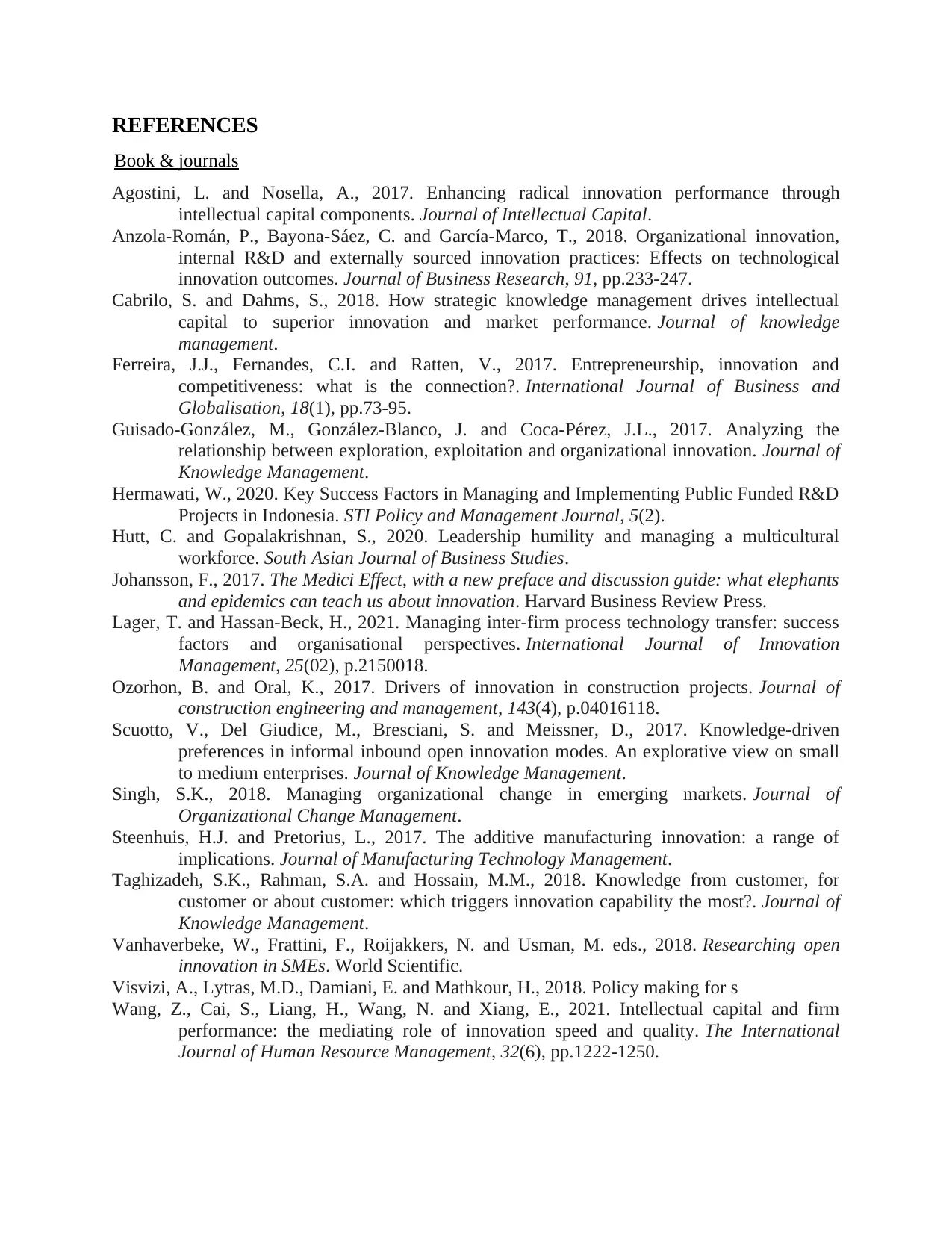
REFERENCES
Book & journals
Agostini, L. and Nosella, A., 2017. Enhancing radical innovation performance through
intellectual capital components. Journal of Intellectual Capital.
Anzola-Román, P., Bayona-Sáez, C. and García-Marco, T., 2018. Organizational innovation,
internal R&D and externally sourced innovation practices: Effects on technological
innovation outcomes. Journal of Business Research, 91, pp.233-247.
Cabrilo, S. and Dahms, S., 2018. How strategic knowledge management drives intellectual
capital to superior innovation and market performance. Journal of knowledge
management.
Ferreira, J.J., Fernandes, C.I. and Ratten, V., 2017. Entrepreneurship, innovation and
competitiveness: what is the connection?. International Journal of Business and
Globalisation, 18(1), pp.73-95.
Guisado-González, M., González-Blanco, J. and Coca-Pérez, J.L., 2017. Analyzing the
relationship between exploration, exploitation and organizational innovation. Journal of
Knowledge Management.
Hermawati, W., 2020. Key Success Factors in Managing and Implementing Public Funded R&D
Projects in Indonesia. STI Policy and Management Journal, 5(2).
Hutt, C. and Gopalakrishnan, S., 2020. Leadership humility and managing a multicultural
workforce. South Asian Journal of Business Studies.
Johansson, F., 2017. The Medici Effect, with a new preface and discussion guide: what elephants
and epidemics can teach us about innovation. Harvard Business Review Press.
Lager, T. and Hassan-Beck, H., 2021. Managing inter-firm process technology transfer: success
factors and organisational perspectives. International Journal of Innovation
Management, 25(02), p.2150018.
Ozorhon, B. and Oral, K., 2017. Drivers of innovation in construction projects. Journal of
construction engineering and management, 143(4), p.04016118.
Scuotto, V., Del Giudice, M., Bresciani, S. and Meissner, D., 2017. Knowledge-driven
preferences in informal inbound open innovation modes. An explorative view on small
to medium enterprises. Journal of Knowledge Management.
Singh, S.K., 2018. Managing organizational change in emerging markets. Journal of
Organizational Change Management.
Steenhuis, H.J. and Pretorius, L., 2017. The additive manufacturing innovation: a range of
implications. Journal of Manufacturing Technology Management.
Taghizadeh, S.K., Rahman, S.A. and Hossain, M.M., 2018. Knowledge from customer, for
customer or about customer: which triggers innovation capability the most?. Journal of
Knowledge Management.
Vanhaverbeke, W., Frattini, F., Roijakkers, N. and Usman, M. eds., 2018. Researching open
innovation in SMEs. World Scientific.
Visvizi, A., Lytras, M.D., Damiani, E. and Mathkour, H., 2018. Policy making for s
Wang, Z., Cai, S., Liang, H., Wang, N. and Xiang, E., 2021. Intellectual capital and firm
performance: the mediating role of innovation speed and quality. The International
Journal of Human Resource Management, 32(6), pp.1222-1250.
Book & journals
Agostini, L. and Nosella, A., 2017. Enhancing radical innovation performance through
intellectual capital components. Journal of Intellectual Capital.
Anzola-Román, P., Bayona-Sáez, C. and García-Marco, T., 2018. Organizational innovation,
internal R&D and externally sourced innovation practices: Effects on technological
innovation outcomes. Journal of Business Research, 91, pp.233-247.
Cabrilo, S. and Dahms, S., 2018. How strategic knowledge management drives intellectual
capital to superior innovation and market performance. Journal of knowledge
management.
Ferreira, J.J., Fernandes, C.I. and Ratten, V., 2017. Entrepreneurship, innovation and
competitiveness: what is the connection?. International Journal of Business and
Globalisation, 18(1), pp.73-95.
Guisado-González, M., González-Blanco, J. and Coca-Pérez, J.L., 2017. Analyzing the
relationship between exploration, exploitation and organizational innovation. Journal of
Knowledge Management.
Hermawati, W., 2020. Key Success Factors in Managing and Implementing Public Funded R&D
Projects in Indonesia. STI Policy and Management Journal, 5(2).
Hutt, C. and Gopalakrishnan, S., 2020. Leadership humility and managing a multicultural
workforce. South Asian Journal of Business Studies.
Johansson, F., 2017. The Medici Effect, with a new preface and discussion guide: what elephants
and epidemics can teach us about innovation. Harvard Business Review Press.
Lager, T. and Hassan-Beck, H., 2021. Managing inter-firm process technology transfer: success
factors and organisational perspectives. International Journal of Innovation
Management, 25(02), p.2150018.
Ozorhon, B. and Oral, K., 2017. Drivers of innovation in construction projects. Journal of
construction engineering and management, 143(4), p.04016118.
Scuotto, V., Del Giudice, M., Bresciani, S. and Meissner, D., 2017. Knowledge-driven
preferences in informal inbound open innovation modes. An explorative view on small
to medium enterprises. Journal of Knowledge Management.
Singh, S.K., 2018. Managing organizational change in emerging markets. Journal of
Organizational Change Management.
Steenhuis, H.J. and Pretorius, L., 2017. The additive manufacturing innovation: a range of
implications. Journal of Manufacturing Technology Management.
Taghizadeh, S.K., Rahman, S.A. and Hossain, M.M., 2018. Knowledge from customer, for
customer or about customer: which triggers innovation capability the most?. Journal of
Knowledge Management.
Vanhaverbeke, W., Frattini, F., Roijakkers, N. and Usman, M. eds., 2018. Researching open
innovation in SMEs. World Scientific.
Visvizi, A., Lytras, M.D., Damiani, E. and Mathkour, H., 2018. Policy making for s
Wang, Z., Cai, S., Liang, H., Wang, N. and Xiang, E., 2021. Intellectual capital and firm
performance: the mediating role of innovation speed and quality. The International
Journal of Human Resource Management, 32(6), pp.1222-1250.
⊘ This is a preview!⊘
Do you want full access?
Subscribe today to unlock all pages.

Trusted by 1+ million students worldwide
1 out of 12
Related Documents
Your All-in-One AI-Powered Toolkit for Academic Success.
+13062052269
info@desklib.com
Available 24*7 on WhatsApp / Email
![[object Object]](/_next/static/media/star-bottom.7253800d.svg)
Unlock your academic potential
Copyright © 2020–2025 A2Z Services. All Rights Reserved. Developed and managed by ZUCOL.





